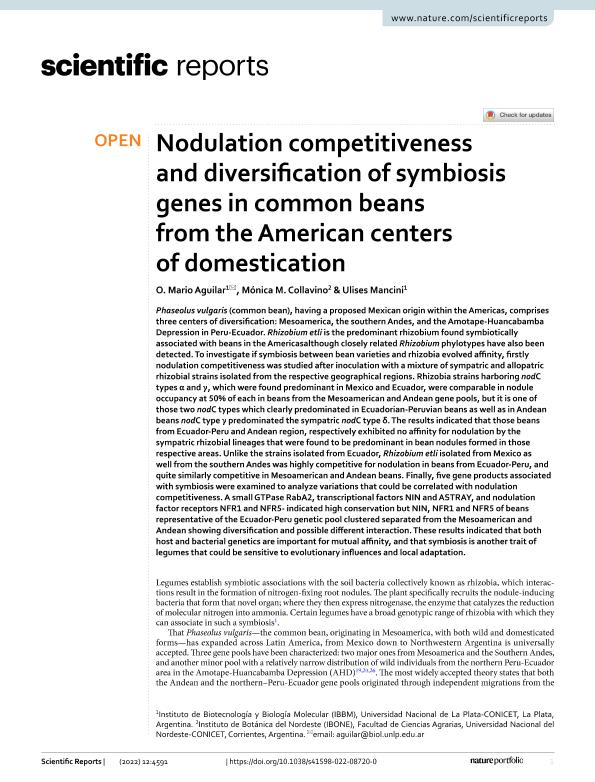Mostrar el registro sencillo del ítem
dc.contributor.author
Aguilar, Orlando Mario

dc.contributor.author
Collavino, Mónica Mariana

dc.contributor.author
Mancini Villagra, Ulises Maximiliano

dc.date.available
2023-09-29T12:21:21Z
dc.date.issued
2022-03
dc.identifier.citation
Aguilar, Orlando Mario; Collavino, Mónica Mariana; Mancini Villagra, Ulises Maximiliano; Nodulation competitiveness and diversification of symbiosis genes in common beans from the American centers of domestication; Springer Nature; Scientific Reports; 12; 1; 3-2022; 1-9
dc.identifier.uri
http://hdl.handle.net/11336/213552
dc.description.abstract
Phaseolus vulgaris (common bean), having a proposed Mexican origin within the Americas, comprises three centers of diversification: Mesoamerica, the southern Andes, and the Amotape-Huancabamba Depression in Peru-Ecuador. Rhizobium etli is the predominant rhizobium found symbiotically associated with beans in the Americasalthough closely related Rhizobium phylotypes have also been detected. To investigate if symbiosis between bean varieties and rhizobia evolved affinity, firstly nodulation competitiveness was studied after inoculation with a mixture of sympatric and allopatric rhizobial strains isolated from the respective geographical regions. Rhizobia strains harboring nodC types α and γ , which were found predominant in Mexico and Ecuador, were comparable in nodule occupancy at 50% of each in beans from the Mesoamerican and Andean gene pools, but it is one of those two nodC types which clearly predominated in Ecuadorian-Peruvian beans as well as in Andean beans nodC type γ predominated the sympatric nodC type δ. The results indicated that those beans from Ecuador-Peru and Andean region, respectively exhibited no affinity for nodulation by the sympatric rhizobial lineages that were found to be predominant in bean nodules formed in those respective areas. Unlike the strains isolated from Ecuador, Rhizobium etli isolated from Mexico as well from the southern Andes was highly competitive for nodulation in beans from Ecuador-Peru, and quite similarly competitive in Mesoamerican and Andean beans. Finally, five gene products associated with symbiosis were examined to analyze variations that could be correlated with nodulation competitiveness. A small GTPase RabA2, transcriptional factors NIN and ASTRAY, and nodulation factor receptors NFR1 and NFR5- indicated high conservation but NIN, NFR1 and NFR5 of beans representative of the Ecuador-Peru genetic pool clustered separated from the Mesoamerican and Andean showing diversification and possible different interaction. These results indicated that both host and bacterial genetics are important for mutual affinity, and that symbiosis is another trait of legumes that could be sensitive to evolutionary influences and local adaptation.
dc.format
application/pdf
dc.language.iso
eng
dc.publisher
Springer Nature
dc.rights
info:eu-repo/semantics/openAccess
dc.rights.uri
https://creativecommons.org/licenses/by-nc-sa/2.5/ar/
dc.subject
Phaseolus vulgaris (frijol)
dc.subject
Rhizobium
dc.subject
Nodulation
dc.subject
NFRs genes
dc.subject.classification
Ecología

dc.subject.classification
Ciencias Biológicas

dc.subject.classification
CIENCIAS NATURALES Y EXACTAS

dc.title
Nodulation competitiveness and diversification of symbiosis genes in common beans from the American centers of domestication
dc.type
info:eu-repo/semantics/article
dc.type
info:ar-repo/semantics/artículo
dc.type
info:eu-repo/semantics/publishedVersion
dc.date.updated
2023-07-04T10:57:25Z
dc.identifier.eissn
2045-2322
dc.journal.volume
12
dc.journal.number
1
dc.journal.pagination
1-9
dc.journal.pais
Reino Unido

dc.journal.ciudad
Londres
dc.description.fil
Fil: Aguilar, Orlando Mario. Consejo Nacional de Investigaciones Científicas y Técnicas. Centro Científico Tecnológico Conicet - La Plata. Instituto de Biotecnología y Biología Molecular. Universidad Nacional de La Plata. Facultad de Ciencias Exactas. Instituto de Biotecnología y Biología Molecular; Argentina
dc.description.fil
Fil: Collavino, Mónica Mariana. Consejo Nacional de Investigaciones Científicas y Técnicas. Centro Científico Tecnológico Conicet - Nordeste. Instituto de Botánica del Nordeste. Universidad Nacional del Nordeste. Facultad de Ciencias Agrarias. Instituto de Botánica del Nordeste; Argentina
dc.description.fil
Fil: Mancini Villagra, Ulises Maximiliano. Consejo Nacional de Investigaciones Científicas y Técnicas. Centro Científico Tecnológico Conicet - La Plata. Instituto de Biotecnología y Biología Molecular. Universidad Nacional de La Plata. Facultad de Ciencias Exactas. Instituto de Biotecnología y Biología Molecular; Argentina
dc.journal.title
Scientific Reports
dc.relation.alternativeid
info:eu-repo/semantics/altIdentifier/url/https://www.nature.com/articles/s41598-022-08720-0
dc.relation.alternativeid
info:eu-repo/semantics/altIdentifier/doi/http://dx.doi.org/10.1038/s41598-022-08720-0
Archivos asociados
